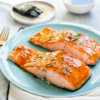Choosing the Best Pans for Cooking Fish: Your Ultimate Guide
Cooking fish can be a delightful culinary adventure, but it often requires the right tools to achieve perfection. When it comes to cooking fish, selecting the appropriate pan is crucial for ensuring your fillets come out tender, flaky, and flavorful. In this comprehensive guide, we’ll explore the different types of pans suitable for cooking fish and provide you with insights on how to make the best choice for your seafood dishes.
1. Non-Stick Skillet:
A non-stick skillet is one of the most versatile options for cooking fish. It allows you to cook fish fillets with minimal oil, preventing them from sticking to the pan and breaking apart. Non-stick skillets are available in various sizes, making them suitable for both small and large fish fillets.

2. Cast Iron Skillet:
Cast iron skillets are known for their even heat distribution and retention. They work exceptionally well for cooking fish with crispy skin, such as salmon. Preheat the cast iron skillet, add some oil, and place the fish skin-side down for a perfect sear. Cast iron skillets also add a delicious rustic flavor to your fish.
3. Stainless Steel Pan:
Stainless steel pans are a popular choice for cooking fish, especially when you want to achieve a nice sear. To prevent sticking, make sure the pan is preheated, and the fish is dry before placing it in the pan. Stainless steel pans are also easy to clean and maintain.
4. Grill Pan:
A grill pan is an excellent option if you’re looking to impart smoky grill marks and flavors to your fish without using an outdoor grill. These pans feature ridges that allow excess fat to drain away, resulting in a crispy exterior while keeping the interior moist.
5. Enamel-Coated Cast Iron Pan:
Enamel-coated cast iron pans combine the benefits of cast iron with a non-reactive enamel coating. They are perfect for cooking fish dishes that require simmering or braising, such as fish stews or chowders. The enamel coating prevents the fish from absorbing any metallic flavors.
6. Fish Poacher:
For larger fish or whole fish preparations, a fish poacher is an ideal choice. These specialized pans are long and shallow, designed to accommodate the entire fish. They often come with a removable rack to help lift the fish out of the poaching liquid.

Tips for Cooking Fish:
- Seasoning: Don’t forget to season your fish with salt, pepper, and your favorite herbs and spices before cooking. This enhances the flavor of the fish.
- Proper Preheating: Ensure that your pan is thoroughly preheated before adding the fish. This helps achieve a good sear and prevents sticking.
- Skin-Side Down: If your fish has skin, start by cooking it skin-side down to achieve crispy skin. Finish cooking on the other side until the fish flakes easily.
- Avoid Overcooking: Fish cooks quickly, so keep a close eye on it to avoid overcooking. The fish is done when it easily flakes with a fork.
- Resting Time: After cooking, let your fish rest for a few minutes. This allows the juices to redistribute, keeping the fish moist and flavorful.
Selecting the right pan for cooking fish is essential for achieving the best results in your seafood dishes. Whether you choose a non-stick skillet, cast iron, stainless steel, or a specialized fish poacher, each pan has its unique advantages. With the proper pan and cooking techniques, you can enjoy delicious and perfectly cooked fish every time you step into the kitchen.


